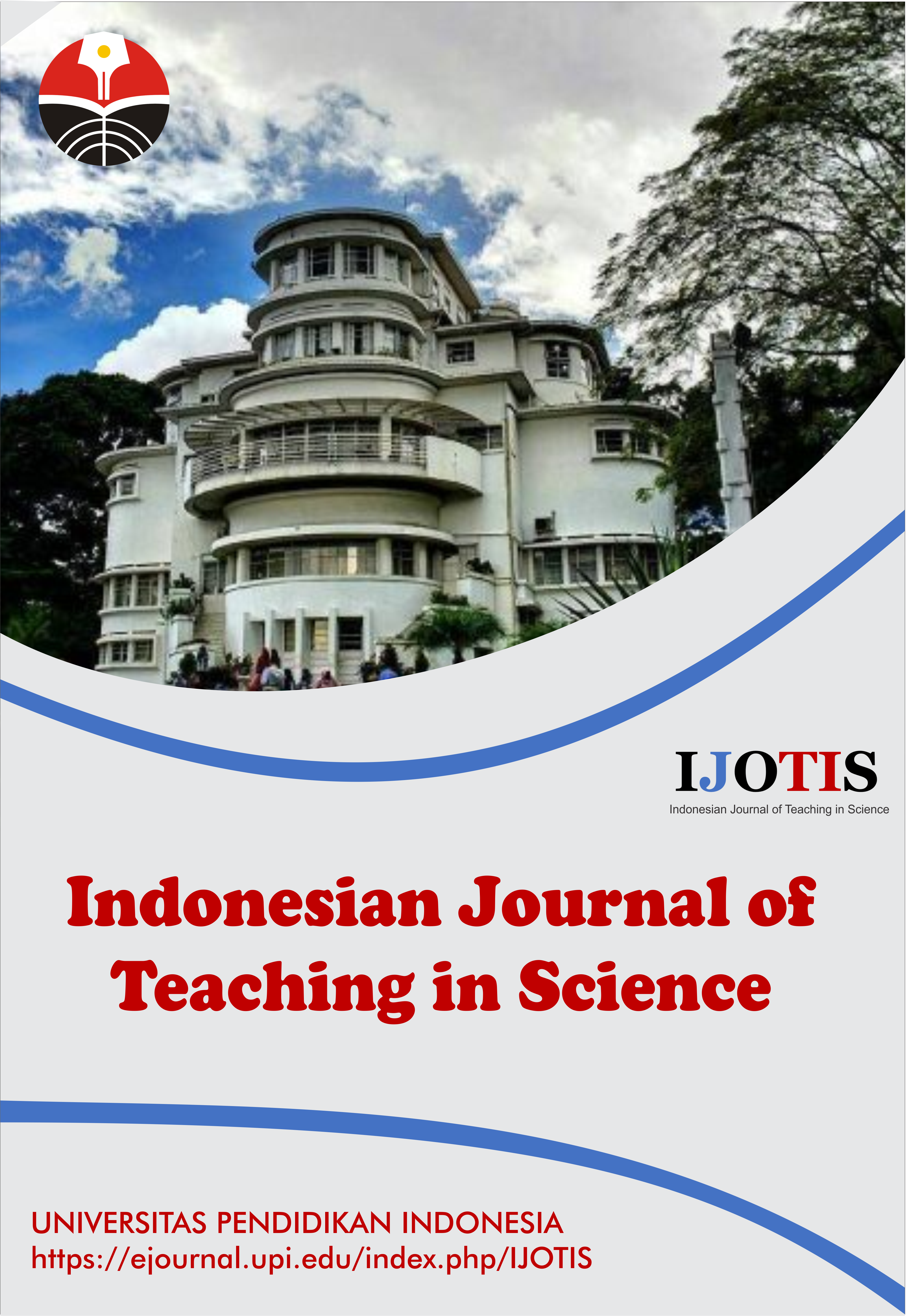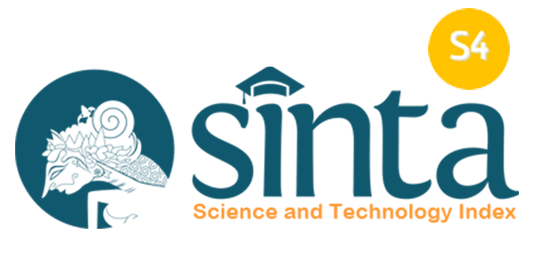The Effects of Digital Media Instruction on Senior High School Students’ Performance in Organic Chemistry Nomenclature
Abstract
Keywords
Full Text:
PDFReferences
Akcay, H., Durmaz, A., Tuysuz, C., and Feyzioglu, B. (2006). Effects of computer-based learning on students' attitudes and achievements towards analytical Chemistry. Online Submission, 5(1), 1-5.
Baek, J. H., Keath, A., and Elliott, E. (2018). Physical education teachers’ technology practices and challenges. International Journal of Human Movement Science, 12(2), 27-42.
Bhukuvhani, C., Zezekwa, N., and Sunzuma, G. (2011). Students’ preparedness to integrate ICT tools and resources for the learning of organic Chemistry concepts in the district of Masvingo, Zimbabwe. International Journal of Education and Development using Information and Communication Technology (IJEDICT), 7(2), 27-37.
Bodsworth, H., and Goodyear, V. A. (2017). Barriers and facilitators to using digital technologies in the cooperative learning model in physical education. Physical Education and Sport Pedagogy, 22(6), 563-579.
Brock, S. J., Russell, J. A., Cosgrove, B., and Richards, J. (2018). Administrative strategies for delivering high-quality instruction in a university-based physical activity and wellness program. Kinesiology Review, 7(4), 345-349.
Campbell, L. O., and Cox, T. D. (2018). Digital video as a personalized learning assignment: A qualitative study of student-authored video using the ICSDR Model. Journal of the Scholarship of Teaching and Learning, 18(1), 11-24.
Casey, A., Goodyear, V. A., and Armour, K. M. (2017). Rethinking the relationship between pedagogy, technology and learning in health and physical education. Sport, Education and Society, 22(2), 288-304.
Cochrane, T., Antonczak, L., Keegan, H., and Narayan, V. (2014). Riding the wave of BYOD: Developing a framework for creative pedagogies. Research in Learning Technology, 22, 1-14.
Emron, S., and Dhindsa, H. S. (2010). Integration of interactive whiteboard technology to improve secondary science teaching and learning. International Journal for Research in Education, 28, 1-24.
Ezeudu, F. O., and Ezinwanne, O. P. (2013). Effect of simulation on students’ achievement in senior secondary school chemistry in Enugu East Local Government Area of Enugu State, Nigeria. Journal of Education and Practice, 4(19), 84-89.
Funkhouser, C. (1993). The influence of problem-solving software on student attitudes about mathematics. Journal of Research on Computing in Education, 25(3), 339-346.
Goldstein, S. P., Forman, E. M., Butryn, M. L., and Herbert, J. D. (2017). Differential programming needs of college students preferring web-based versus in-person physical activity programs. Health Communication, 33(12), 1509-1515.
Gross, M. M., Wright, M. C., and Anderson, O. S. (2017). Effects of image‐based and text-based active learning exercises on student examination performance in a musculoskeletal anatomy course. Anatomical Sciences Education, 10(5), 444-455
Guse, K., Levine, D., Martins, S., Lira, A., Gaarde, J., Westmorland, W., and Gilliam, M. (2012). Interventions using new digital media to improve adolescent sexual health: A systematic review. Journal of Adolescent Health, 51(6), 535-543.
Henriques, L. (2002). Children's ideas about the weather: A review of the literature. School Science and Mathematics, 102(5), 202-215.
Heo, M. (2009). Digital storytelling: An empirical study of the impact of digital storytelling on pre-service teachers’ self-efficacy and dispositions towards educational technology. Journal of Educational Multimedia and Hypermedia,18(4), 405-428
Jaji, G. (1994). Curriculum implementation in sixth form Mathematics classes in Zimbabwe. Zimbabwe Journal of Educational Research, 6(1), 69-88.
Koc, M., and Barut, E. (2016). Development and validation of New Media Literacy Scale (NMLS) for university students. Computers in Human Behaviour, 63, 834-843.
Kolarik, Z., Müllich, U., and Gassner, F. (1999). Selective extraction of Am (III) over Eu (III) by 2, 6-ditriazolyl-and 2, 6-ditriazinylpyridines. Solvent Extraction and Ion Exchange, 17(1), 23-32.
Kolb, D. A. (1976). Management and the learning process. California Management Review, 18(3), 21-31.
Kretschmann, R. (2015). Physical Education Teachers' Subjective Theories about Integrating Information and Communication Technology (ICT) into Physical Education. Turkish Online Journal of Educational Technology-TOJET, 14(1), 68-96.
Lim, J., Pellett, H. H., and Pellett, T. (2009). Integrating digital video technology in the classroom. Journal of Physical Education, Recreation and Dance, 80(6), 40-55.
Loizzo, J., Ertmer, P. A., Watson, W. R., and Watson, S. L. (2017). Adult MOOC learners as self-directed: Perceptions of motivation, success, and completion. Online Learning, 21(2), 2.
Melchor-Couto, S. (2019). Virtual worlds and language learning. Journal of Gaming and Virtual Worlds, 11(1), 29-43.
Melton, B., and Burdette, T. (2011). Utilizing technology to improve the administration of instructional Appropriate/Inappropriate Practices programs in higher education. Journal of Physical Education, Recreation and Dance, 82(4), 27-32.
Melton, B., Harris, H. B. B., Kelly, D., and Chandler, K. (2015). Evaluating a physical activity app in the classroom: A mixed methodological approach among. The Physical Educator, 72, 601-620.
Reynolds, R. (2016). Defining, designing for, and measuring “social constructivist digital literacy” development in learners: a proposed framework. Educational Technology Research and Development, 64(4), 735-762.
Ryles, A. P. (1990). Teaching A-level organic chemistry mechanisms: Some suggestions. School Science Review, 72(258), 71-74.
Schmidt, H.J. (1992). Students' understanding of boiling points and intermolecular forces. Chemistry Education Research and Practice, 10, 265-272.
Siddiqui, U., and Khatoon, T. (2013). Teaching physical science: should we implement teacher-centered CAI or student-centered CAI at secondary school level in India? European Scientific Journal, 9(10), 136-149.
Sirhan, G. (2007). Learning difficulties in Chemistry: An overview. Journal of Turkish Science Education, 4(2), 2-20
Skonieczy, S. (2006). IUPAC rules for naming organic molecules. Journal of Chemical Education, 83(11), 1633-1643.
Stapleton, D. T., Taliaferro, A. R., and Bulger, S. M. (2017). Teaching an old dog new tricks: Past, present, and future priorities for higher education physical activity programs. Quest, 69(3), 401-418.
Tiernan, P. (2015). An inquiry into the current and future uses of digital video in university teaching. Education and Information Technologies, 20(1), 75-90.
Ungerer, J., (2016). CRISPR/Cas9 mediated targeted mutagenesis of the fast-growing cyanobacterium Synechococcus elongatus UTEX 2973. Microbial Cell Factories, 15, 1-8.
Weir, T., and Connor, S. (2009). The use of digital video in physical education. Technology, Pedagogy and Education, 18(2), 155-171.
Yusuf, M. O., and Afolabi, A. O. (2010). Effects of Computer Assisted Instruction (CAI) on secondary school students’ performance in biology. Turkish Online Journal of Educational Technology, 9, 62-69.
DOI: https://doi.org/10.17509/ijotis.v4i1.68763
Refbacks
- There are currently no refbacks.
Copyright (c) 2024 Universitas Pendidikan Indonesia

This work is licensed under a Creative Commons Attribution-ShareAlike 4.0 International License.
Indonesian Journal of Teaching in Science (IJoTIS) is published by Universitas Pendidikan Indonesia (UPI)
 Indonesian Journal of Teaching in Science
Indonesian Journal of Teaching in Science



